With Russian forces in the north bottled up in the siege of Leningrad, and those in the south destroyed in the fall of Kiev, on 2 October Hitler gave the order for Operation Typhoon, the final assault on Moscow by German forces in the centre. Almost at once the Germans began to outflank and overwhelm Soviet defensive positions established between them and the capital. In the Ukraine, German SS soldiers committed the largest mass murder of the war, killing almost 34,000 Jews at Babi Yar ravine just outside Kiev between 29 and 30 September. Also this week, in India Mahatma Ghandi urged his followers to adopt “passive resistance” to British rule.
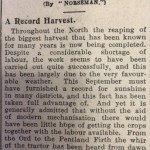 Back in Caithness the John O’Groat Journal reported that farmers were experiencing “the biggest harvest that has been known for many years.” The paper attributed this to the very favourable weather: “This September must have furnished a record for sunshine in many districts… From the Ord to the Pentland Firth the whir of the tractor has been heard from dawn to dusk.”
Back in Caithness the John O’Groat Journal reported that farmers were experiencing “the biggest harvest that has been known for many years.” The paper attributed this to the very favourable weather: “This September must have furnished a record for sunshine in many districts… From the Ord to the Pentland Firth the whir of the tractor has been heard from dawn to dusk.”
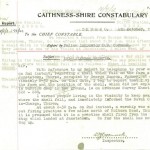 The risk to the inhabitants of Caithness from friendly fire had still not gone away. On 4 October Police Inspector Cormack reported, “With reference to my report … regarding a shell which fell on the farm at Janetstown, Thurso, occupied by George Manson, Farmer … I beg to report that I visited the farm and the position of the shell, which did not explode, but is buried deep in the ground… At about 2-30 p.m. on 2nd instant, a warship was carrying out firing practice a few miles north of Holborn Head, Thurso, and it is presumed that it is a practice shell fired from this ship which landed at Janetstown. So far the shell has not been dug up.”
The risk to the inhabitants of Caithness from friendly fire had still not gone away. On 4 October Police Inspector Cormack reported, “With reference to my report … regarding a shell which fell on the farm at Janetstown, Thurso, occupied by George Manson, Farmer … I beg to report that I visited the farm and the position of the shell, which did not explode, but is buried deep in the ground… At about 2-30 p.m. on 2nd instant, a warship was carrying out firing practice a few miles north of Holborn Head, Thurso, and it is presumed that it is a practice shell fired from this ship which landed at Janetstown. So far the shell has not been dug up.”
Military operations don’t usually appear in the local records or newspapers, but a letter from the Secretary of the 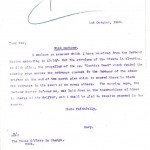 Wick Harbour Trust to the “Naval Officer in Charge” this week hints at the steps taken to defend the harbour: “I enclose an account which I have received from the Harbour Master amounting to £3:18s. for the services of the divers in clearing, on 27th ulto., the propeller of the S.S. “Cantick Head” which fouled the mooring rope across the entrance channel to the Harbour of the steam drifter at the end of the north pier which is moored there to block the entrance in the event of an enemy attack. The mooring rope, the Harbour Master informs me, was laid down on the instructions of those in charge of the drifter.” (In other words, the Navy put the rope there – so let the Navy pay for it.)
Wick Harbour Trust to the “Naval Officer in Charge” this week hints at the steps taken to defend the harbour: “I enclose an account which I have received from the Harbour Master amounting to £3:18s. for the services of the divers in clearing, on 27th ulto., the propeller of the S.S. “Cantick Head” which fouled the mooring rope across the entrance channel to the Harbour of the steam drifter at the end of the north pier which is moored there to block the entrance in the event of an enemy attack. The mooring rope, the Harbour Master informs me, was laid down on the instructions of those in charge of the drifter.” (In other words, the Navy put the rope there – so let the Navy pay for it.)
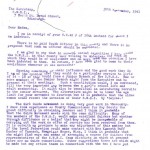 The Director of Education wrote this week to the Secretary of the Scottish Women’s Rural Institute (SWRI), suggesting they form a junior branch for girls aged 14-18; “the alternative might be to lower the age limit for your movement to fourteen but it is probable that the older women would resent the invasion of their SWRI by ‘bairns’.” He added that, “the Girl Guide movement is doing very good work in the county,” but leaders were hard to come by. “Many of the members of the SWRI would make excellent Guiders but whether through diffidence or a belief that they might be incapable of carrying out the work no offer of service has been received by them.”
The Director of Education wrote this week to the Secretary of the Scottish Women’s Rural Institute (SWRI), suggesting they form a junior branch for girls aged 14-18; “the alternative might be to lower the age limit for your movement to fourteen but it is probable that the older women would resent the invasion of their SWRI by ‘bairns’.” He added that, “the Girl Guide movement is doing very good work in the county,” but leaders were hard to come by. “Many of the members of the SWRI would make excellent Guiders but whether through diffidence or a belief that they might be incapable of carrying out the work no offer of service has been received by them.”
Finally this week, the John O’Groat Journal reported that between April and June this year, “there were in 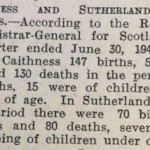 Caithness 147 births, 53 marriages and 130 deaths. Of the deaths, 15 were of children under one year of age. In Sutherland for the same period there were 70 births, 14 marriages and 80 deaths, seven of the deaths being children under one year.”
Caithness 147 births, 53 marriages and 130 deaths. Of the deaths, 15 were of children under one year of age. In Sutherland for the same period there were 70 births, 14 marriages and 80 deaths, seven of the deaths being children under one year.”
